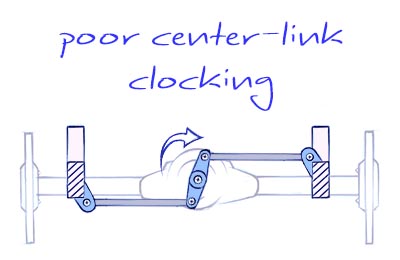
If you have been living under one of those rocks that people like to judge others for (don’t worry, you’ll get no judgments here) or don’t spend any time on the internet arguing with people about which Spice Girl was the best, then you might be wondering what a Watts-link is… And honestly, that’s fair!
A Watts-link is a type of lateral locating device (LLD) that uses two “side-links” and a “center-link” to control the lateral (side-to-side) movement of an axle. And when set up correctly, a Watts-link should not create any lateral movement of the axle while the suspension cycles the way a panhard bar will.
Allow me to clarify – the lateral movement created by a properly set-up panhard bar is not at all a bad thing. You are certainly welcome to have a differing opinion, but that does not make the panhard bar a bad or wrong choice for others. If you still disagree, I encourage you to write a letter to your congressperson.

Meanwhile, the problem with a Watts-link is that if they are not set up correctly, they can potentially create lateral movement at the axle. This can be particularly frustrating for a beginner since the internet says Watts-links are perfect and amazing in all situations. However, that is simply not true.
What a Watts-link is though, is one of the most complicated LLDs you would run on your street driven vehicle. This means when they aren’t set up correctly, you are just wasting time, money, and space.
Then how do we make sure our Watts-link doesn’t cause any lateral axle movement?
Thankfully, Watts-links are fairly simple to set up, and in an effort to make things even easier to understand, we put this video together:
Before we go on, if you are curious what “half-travel” is, check out this video
I understand that it’s not going to be easy for some people to extrapolate enough information from the Watts-link video to know if your suspension is set up correctly, so let me ask you two questions:
When your suspension is at the half-travel position, are your links . . .


If you’re still not sure if your Watts-link is set up correctly, does it look like either of these photos?
Both of these will cause the axle to pull laterally as the suspension runs through its travel. However, while an improperly clocked center-link may only pull the axle off-center at one extreme of the total travel, a system that is set up with non-parallel links will most likely pull the axle around at all points of the travel.

The tricky part about Watts-links is that aside from my video that shows how the parts should be oriented with each other at the different points of the suspension travel, there are no other universal answers for them.
“How long should the side-links be to accommodate “X” amount of travel?”
I don’t know? What is the overall length of your center-link?
“How long should the center-link be to accommodate “X” amount of travel?”
I don’t know? How long are your side-links?
“What angle should the center-link be when the suspension is at half-travel?”
I don’t know? How long are your side-links, and how much total travel does your suspension have?
It might sound like I’m cheating or trying to sell my book here, but there are so many variables to every Watts-link configuration, it’s impossible to apply a blanket rule to their set up. And you should be leery of anyone who claims there is a universal rule, to be honest. Even if I developed a universal kit, I would still have to create a calculator for people to determine the proper geometry based on their specific situation… Which might be an idea for a future project!
So for now, I hope this helps you find some hidden gremlins you’ve been fighting or keeps you from creating your own gremlins. Either way – don’t feed them after midnight!

Max Fish is the author of the Air Suspension Design book and has been the owner/operator of the custom fabrication shop Bio Kustumz since 1997. His specialty is developing viable suspension designs for vehicles with unique or challenging confines. He also believes that focusing on a premium driver experience is a critical part of the design process.
Max Fish – Personal Facebook and Personal Instagram
Air Suspension Book – Facebook and Instagram
Bio Kustumz – Instagram

